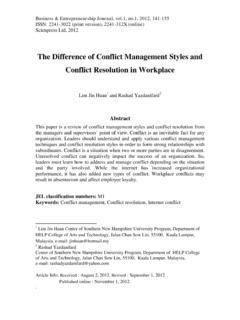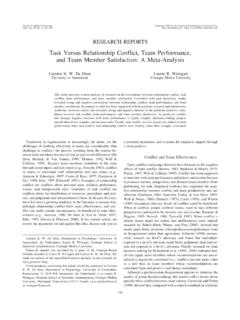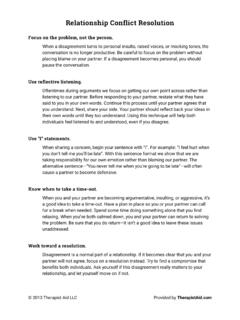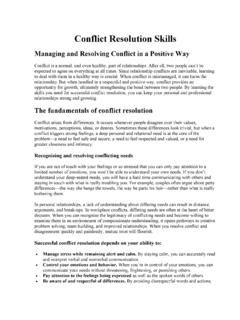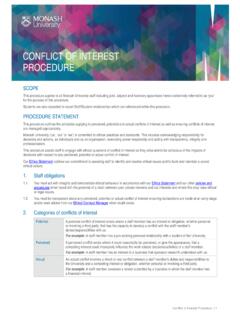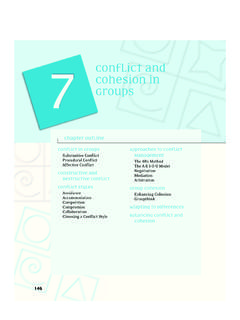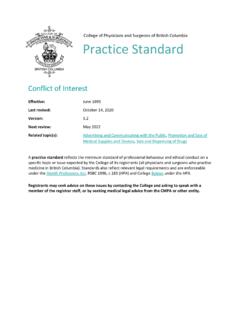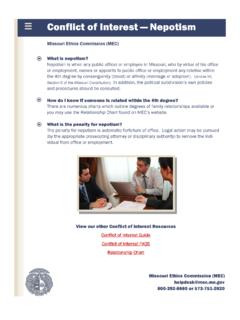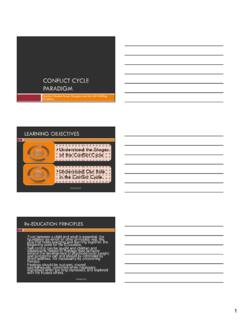Transcription of Conflict Resolution Diagram - Agile Coach
1 The Conflict Resolution Diagram The Logical Thinking Process The Logical Thinking Process is a set of Systems Thinking tools that helps us to understand goals and problems and come up with breakthrough solutions. The tools were first presented by Eli Goldratt in his novel It's Not Luck , a sequel to The Goal . Several textbooks have been written to explain how to apply these tools. The following is based mainly on The Logical Thinking Process by H. William Dettmer. The Conflict Resolution Diagram (CRD) is used to better understand conflicts between two ideas or two courses of action. The CRD is sometimes called the Evaporating Cloud . We don't use the Conflict Resolution Diagram for interpersonal conflicts . The Conflict Resolution Diagram may help to clarify a Conflict of ideas which is one of the causes of the interpersonal Conflict .
2 When do I use a Conflict Resolution Diagram ? 1. You know what your goal is and which critical success factors and necessary conditions you need to achieve the goal. If not, use the Intermediate Objectives Map to clarify your goal. 2. You know that you miss one or more of the necessary conditions to reach your goal. You've examined the root causes that cause this undesirable situation. If not, use the Current Reality Tree to find those root causes. 3. You see that the root causes of the undesirable situation arise out of a Conflict , which can have one of two forms: Contradiction: one branch of the reasoning leads to I must do X ;. another branch of the reasoning says I must not do X . For example: the government must spend more money to revive the economy AND. must spend less money to decrease the deficit.
3 I need X AND I need not X. Exclusive alternatives: I need to two necessary conditions to reach my goal, but I can't have both. Typically, we lack the resources (money, time, people ) to pursue both alternatives. For example: I need to spend time at work delivering value AND I need to spend time at work learning BUT I don't have time to both. I need X AND Y BUT I can't have both or I need to choose between X OR Y. 4. Apply the Conflict Resolution Diagram to better understand the contradiction or exclusive alternatives. This can have the following outcomes: We discover that the assumptions behind the Conflict are incorrect and there is no Conflict , only a misunderstanding. We discover that the Conflict can be resolved without compromise if we can have or do something, a new fact called an injection . We agree to explore ways of achieving the injection.
4 We can use the next tool, the Future Reality Tree to explore the consequences of implementing the injection. We don't get any further insight into the Conflict , usually because we're unable or unwilling to uncover all assumptions behind our thinking. We recommend you step away from the Conflict and return to 1. it later with the help of people not involved in the Conflict who can bring some fresh questions and perspectives. A win-lose solution or compromise (or lose-lose) solution is not acceptable. 5. Once we have ideas to improve the situation, we explore them using the Future Reality Tree and Prerequisite Tree tools. We can then establish a plan of action using a Transition Tree. Who uses the Conflict Resolution Diagram ? We typically encounter two situations: One person owns the whole Conflict : the Conflict owner is the client and at least one other person helps the client use the Conflict Resolution Diagram as a consultant.
5 The consultant should approach the situation with a completely open mind. The consultant should only ask questions of the following three types: 1. Open Questions invite the interviewee to tell a story. Will you tell me about , What happens next? or Will you give me an example? . 2. Control Questions ask for the facts in the story. How many , How often , Where , Who . 3. Confirmation Questions verify that the interviewer has understood correctly. If I've understood correctly, <explain what you understood>. Is that correct? . Two people each advocate one of the exclusive alternatives. Each advocate fills in half of the Diagram , the side representing the position of the other advocate. Each advocate must at least be willing to ask questions and listen to the other's point of view, they should act as consultant for the other advocate.
6 An independent consultant can help to ensure that the rules of the process are followed. If the advocates can't work together, the consultant can work with each of them independently to clarify their positions and to get some insight into the position of the other advocate, before bringing the two advocates together. In any case, we must avoid trying to find (or worse even, push) solutions when we build a Conflict Resolution Diagram . The aim of the tool is to better understand the problem, before starting to look at possible solutions. If any participant has difficulty with the questions, they should practice with the Nine Boxes technique first. 2. How do we apply the Conflict Resolution Diagram ? We recommend using low tech tools like large sheets of paper, pens and Post-Its. Don't hesitate to replace a Post-It when you can improve the clarity of the Diagram !
7 1. Create a blank Conflict Resolution Diagram Draw the following Diagram on a large sheet of paper. Leave plenty of space around the Diagram . Requirement Prerequisite #1 #1. Objective Requirement Prerequisite #2 #2. Consultant: ask the client to briefly explain the context of the Conflict . Client: briefly give some background information that is required for participants to understand the case you will present. 3. Example: Requirement Prerequisite #1 #1. The cost of a sprint The velocity must must remain increase every sprint constant Objective A happy customer based on the price /. requirements relationship Every sprint, new The complexity of features are built the product increases every sprint Requirement Prerequisite #2 #2. 2. Articulate the Conflict Client: fill in Prerequisite 1 and 2 with the two terms from the Conflict .
8 Consultant: ask questions to ensure that the meaning of the two terms is clear. Example: see CRD above 3. Determine the goal and requirements on each side Consultant: ask the client why they need each prerequisite. You should end up with a statement like In order to have <requirement> we must <prerequisite> . Ask questions to ensure that the requirement is clearly described. Don't question the logic (yet). Client: the requirements usually come directly from your Intermediate Objectives Map. Consultant: find out the common objective of the two requirements. The objective must be concrete and the two requirements must be necessary to achieve the goal. You should end up with a statement like In order to have <objective> we must <requirement 1> AND <requirement 2>. Don't question the logic (yet). Client: the goal usually comes directly from your Intermediate Objectives Map.
9 Clarify the requirements as necessary. Example: see CRD above If we can't find a common goal for the conflicting prerequisites, that can mean two things: There isn't a Conflict because we're looking at two completely unrelated systems 4. We're looking at the wrong level of the system. Say we have the situation: Objective1 requires Requirement1 requires Prerequisite1 and Objective2. requires Requirement2 requires Prerequisite2. Why can't we have both P1. and P2? Because we want both O1 and O2. Why do we need both O1 and O2? Because there's a goal O3 that requires both O1 and O2. O3 is our real objective. 4. Evaluate the entire relationship At this point, it's useful to bring in someone who wasn't involved in the construction of the Diagram . Client: explain the logic of the Diagram by reading the Diagram from left to right: In order to have <objective> we must <requirement 1> and <requirement 2>.
10 In order to have <requirement 1> we must <prerequisite 1>. In order to have <requirement 2> we must <prerequisite 2>. We can't have <prerequisite 1> AND <prerequisite 2>. Consultant: evaluate the clarity of the reasoning. Did we avoid tautologies ( in order to be rich we need lots of money )? Can someone who knows the context immediately understand the Diagram ? If not, ask questions to clarify the five statements. Don't question the logic (yet). Example: we reformulated requirement #2 for clarity. Requirement Prerequisite #1 #1. The cost of a sprint The velocity must must remain increase every sprint constant Objective A happy customer based on the price /. requirements relationship Every sprint, new The complexity of requirements of the the product increases customer are every sprint covered Requirement Prerequisite #2 #2.



